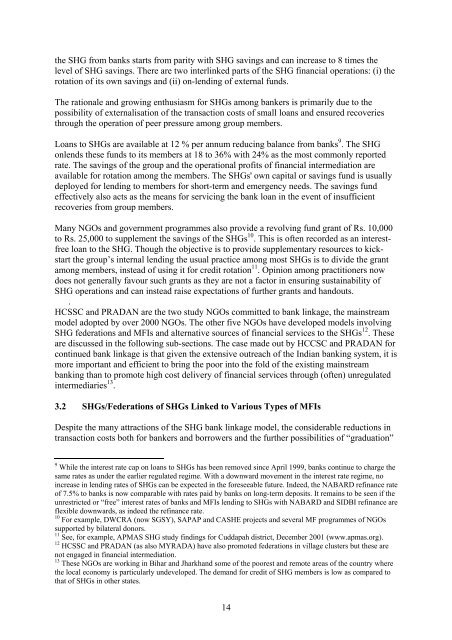Self-help Groups as Financial Intermediaries in India ... - Sa-Dhan
Self-help Groups as Financial Intermediaries in India ... - Sa-Dhan
Self-help Groups as Financial Intermediaries in India ... - Sa-Dhan
Create successful ePaper yourself
Turn your PDF publications into a flip-book with our unique Google optimized e-Paper software.
the SHG from banks starts from parity with SHG sav<strong>in</strong>gs and can <strong>in</strong>cre<strong>as</strong>e to 8 times thelevel of SHG sav<strong>in</strong>gs. There are two <strong>in</strong>terl<strong>in</strong>ked parts of the SHG f<strong>in</strong>ancial operations: (i) therotation of its own sav<strong>in</strong>gs and (ii) on-lend<strong>in</strong>g of external funds.The rationale and grow<strong>in</strong>g enthusi<strong>as</strong>m for SHGs among bankers is primarily due to thepossibility of externalisation of the transaction costs of small loans and ensured recoveriesthrough the operation of peer pressure among group members.Loans to SHGs are available at 12 % per annum reduc<strong>in</strong>g balance from banks 9 . The SHGonlends these funds to its members at 18 to 36% with 24% <strong>as</strong> the most commonly reportedrate. The sav<strong>in</strong>gs of the group and the operational profits of f<strong>in</strong>ancial <strong>in</strong>termediation areavailable for rotation among the members. The SHGs' own capital or sav<strong>in</strong>gs fund is usuallydeployed for lend<strong>in</strong>g to members for short-term and emergency needs. The sav<strong>in</strong>gs fundeffectively also acts <strong>as</strong> the means for servic<strong>in</strong>g the bank loan <strong>in</strong> the event of <strong>in</strong>sufficientrecoveries from group members.Many NGOs and government programmes also provide a revolv<strong>in</strong>g fund grant of Rs. 10,000to Rs. 25,000 to supplement the sav<strong>in</strong>gs of the SHGs 10 . This is often recorded <strong>as</strong> an <strong>in</strong>terestfreeloan to the SHG. Though the objective is to provide supplementary resources to kickstartthe group’s <strong>in</strong>ternal lend<strong>in</strong>g the usual practice among most SHGs is to divide the grantamong members, <strong>in</strong>stead of us<strong>in</strong>g it for credit rotation 11 . Op<strong>in</strong>ion among practitioners nowdoes not generally favour such grants <strong>as</strong> they are not a factor <strong>in</strong> ensur<strong>in</strong>g susta<strong>in</strong>ability ofSHG operations and can <strong>in</strong>stead raise expectations of further grants and handouts..HCSSC and PRADAN are the two study NGOs committed to bank l<strong>in</strong>kage, the ma<strong>in</strong>streammodel adopted by over 2000 NGOs. The other five NGOs have developed models <strong>in</strong>volv<strong>in</strong>gSHG federations and MFIs and alternative sources of f<strong>in</strong>ancial services to the SHGs 12 . Theseare discussed <strong>in</strong> the follow<strong>in</strong>g sub-sections. The c<strong>as</strong>e made out by HCCSC and PRADAN forcont<strong>in</strong>ued bank l<strong>in</strong>kage is that given the extensive outreach of the <strong>India</strong>n bank<strong>in</strong>g system, it ismore important and efficient to br<strong>in</strong>g the poor <strong>in</strong>to the fold of the exist<strong>in</strong>g ma<strong>in</strong>streambank<strong>in</strong>g than to promote high cost delivery of f<strong>in</strong>ancial services through (often) unregulated<strong>in</strong>termediaries 13 .3.2 SHGs/Federations of SHGs L<strong>in</strong>ked to Various Types of MFIsDespite the many attractions of the SHG bank l<strong>in</strong>kage model, the considerable reductions <strong>in</strong>transaction costs both for bankers and borrowers and the further possibilities of “graduation”9 While the <strong>in</strong>terest rate cap on loans to SHGs h<strong>as</strong> been removed s<strong>in</strong>ce April 1999, banks cont<strong>in</strong>ue to charge thesame rates <strong>as</strong> under the earlier regulated regime. With a downward movement <strong>in</strong> the <strong>in</strong>terest rate regime, no<strong>in</strong>cre<strong>as</strong>e <strong>in</strong> lend<strong>in</strong>g rates of SHGs can be expected <strong>in</strong> the foreseeable future. Indeed, the NABARD ref<strong>in</strong>ance rateof 7.5% to banks is now comparable with rates paid by banks on long-term deposits. It rema<strong>in</strong>s to be seen if theunrestricted or “free” <strong>in</strong>terest rates of banks and MFIs lend<strong>in</strong>g to SHGs with NABARD and SIDBI ref<strong>in</strong>ance areflexible downwards, <strong>as</strong> <strong>in</strong>deed the ref<strong>in</strong>ance rate.10 For example, DWCRA (now SGSY), SAPAP and CASHE projects and several MF programmes of NGOssupported by bilateral donors.11 See, for example, APMAS SHG study f<strong>in</strong>d<strong>in</strong>gs for Cuddapah district, December 2001 (www.apm<strong>as</strong>.org).12 HCSSC and PRADAN (<strong>as</strong> also MYRADA) have also promoted federations <strong>in</strong> village clusters but these arenot engaged <strong>in</strong> f<strong>in</strong>ancial <strong>in</strong>termediation.13 These NGOs are work<strong>in</strong>g <strong>in</strong> Bihar and Jharkhand some of the poorest and remote are<strong>as</strong> of the country wherethe local economy is particularly undeveloped. The demand for credit of SHG members is low <strong>as</strong> compared tothat of SHGs <strong>in</strong> other states.14















